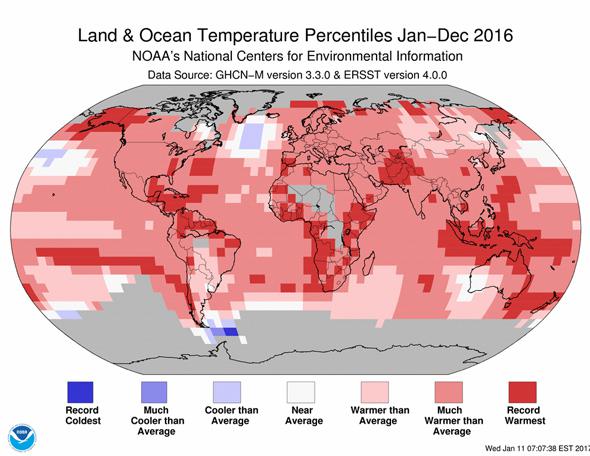Well, it’s official: 2016 was the hottest year globally on record.
The National Oceanic and Atmospheric Administration released its numbers for the year, and there’s no way to sugarcoat this: It’s bad.
We’ve had three consecutive years of record-breaking heat all over the planet.
Looking at land and ocean temperatures, the NOAA finds that the planet in 2016 was the hottest since records began in 1880, with a global average temperature 0.94°C (1.69°F) above the 20th-century average of 13.9°C (57.0°F). That may not sound like much, but it’s actually huge.
Think of it this way: The surface of the Earth is about 200 million square kilometers. All of that, everywhere, is now nearly a degree hotter than it was in the previous century. That’s a vast, staggering amount of extra energy.
Update, Jan. 18, 2017 at 16:20 UTC: NASA’s Goddard Institute for Space Science and Berkeley Earth also released their results, which agree with NOAA: 2016 is the hottest year ever recorded.
As the planet warms, you’d expect the land to heat up faster than the ocean; water responds more slowly to changing temperature. And that’s just what we see: The land only temperature was 1.43°C above the 20th-century average, and the ocean-only temperature was 0.75°C warmer. Both are records; the land temperature easily surpassed 2015, though the ocean temperature was only a bit more than the previous record.
Normally, I’m not too concerned with breaking records; sometimes you get fluctuations due to statistics that can edge out a previous high mark. But in this case it’s different, because we’re talking about a hugely sampled number of temperature measurements taken over a substantial amount of the Earth’s surface.
But what makes this far more worrisome is the trend. If it’s getting hotter, you’d expect the hottest years to be the more recent ones, of course. Well, from the NOAA rankings, 15 of the 16 record hottest years were from 2001–2016, with 2016 being the hottest. Before that, 2015 was the record holder, and before that it was 2014.
The world is heating up.
There’s more. To wit:
- Sea ice in the Arctic has been declining precipitously for some time, but this past year took a huge dip. The average extent for 2016 was about 10 million square kilometers, the lowest on record.
- Record high temperatures were seen all over the planet. Tellingly, no land areas were cooler than average. It was hotter everywhere over Earth’s solid surface.
- 2016 was the second hottest year on record for the contiguous United States, with every single state getting above average temperatures.
- The lower and middle troposphere (the atmosphere from the Earth’s surface up to about 10 km, though it varies by latitude) also saw record high temperatures.
- The stratosphere (the atmospheric layer above the troposphere) saw record cold temperatures, but ironically this is exactly what you expect from global warming (you can get more details of why that is at Real Climate and Yale Climate Connections).

NOAA
Global warming is real, and it’s happening now, and it’s our fault. The overwhelming majority of climate scientists agree with this. Peter Gleick, a scientist who studies the impact of global warming, puts it this way: “Not a single national science academy disputes or denies the scientific consensus around human-caused climate change.” And not just in America, but all over the globe.
Of course, some politicians disagree. And to the detriment of all humanity, many of them are currently in power in the United States, and are about to consolidate that power more. Nearly every single Cabinet nominee Donald Trump has chosen denies the reality of global warming. As my friend and science advocate Sheril Kirshenbaum noted, just getting one of Trump’s appointees to admit that climate change isn’t a hoax is surreally encouraging.
In a world heating up, that’s a tepid victory.
There is some good news, or at least less bad news. President Obama just sent $500 million to the United Nation’s Green Climate Fund, a program to help developing countries—which tend to be the hardest hit by climate change—adapt to this new world. That’s great, but he did it on his way out, and what’s coming in is an administration hellbent on tearing down any legislation to help mitigate global warming that’s been enacted the past eight years.
For example, the House Committee on Science, Space, and Technology still has a GOP majority, and they just added several new reality-denying members. I have little doubt that Rep. Lamar Smith, R-Texas, the committee chairman, will continue his baseless attacks on climate scientists, and I’m sure he will issue a challenge to this newest NOAA hottest year finding, just as I’m sure it will distort the facts. That’s been his modus operandi for years.
Still, there’s hope. I’ve said it before: We need a public that’s excited about science. Most people in America know climate change is real, and want the government to take action about it. The next two years will be very difficult, but then there’s the midterm congressional election. Two years after that is the next presidential election. These elections have consequences, and right now those consequences are more than 700 days of climate inaction, if not outright hostility. We need to be ready to fight legislation taking aim at making our planet hotter, and be ready to throw out our representatives if they deny the science.
Never forget that word: our. They represent us. And if we chose it, then we can put science-friendly legislators back in power. It will literally save humanity.
